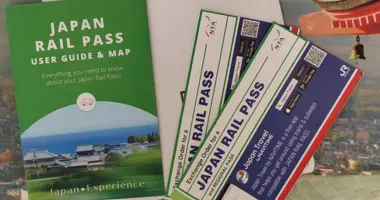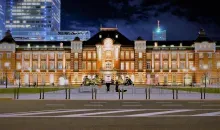Choshi Dentetsu Railway 銚子電気鉄道線
- Published on : 14/11/2016
- by : Japan Experience
- Youtube
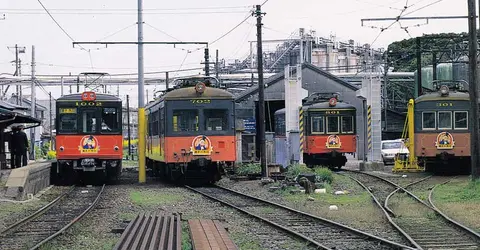
Nakanocho Station - Dentetsu Line train depot, Chiba Prefecture
@Japan Visitor
Choshi Dentetsu Railway is a private railway line connecting Choshi JR Station to the outlying coastal attractions of Choshi in Chiba Prefecture.
Choshi Dentetsu Train Ticket, Choshi, Chiba Prefecture
Most visitors to Choshi arrive at JR Choshi Station, either by the JR Sobu Main Line Limited Express Shiosai straight from Tokyo Station or by the JR Sobu Mainline Local Train from Chiba.
Visitors can change from the Japan Railways (JR) system to the Choshi Dentetsu Line right at Choshi Station. A separate ticket, printed in vintage fashion on thick cardboard, featuring no electronic inscription at all, must be bought to ride the Dentetsu Line. SUICA or PASMO IC cards are not accepted by the Dentetsu Railway.
The Dentetsu Line trains make nine stops (after leaving Choshi Station) before they reach their terminus at Tokawa Station in the old fishing village of Tokawa after covering a distance of 6.4 km in about 28 minutes. Trains run about once an hour, a ticket for an adult covering the whole trip is 700 yen one way.
Stations and Sights
Choshi Station
Choshi Station connects to the JR Sobu Main Line and gives access to downtown Choshi, Kawagishi Park right at the Tone River, Choshi Ohashi Bridge crossing the Tone River, as well as the Yamasa and Higeta soy sauce factories and the historic Yamaju no Hishio soybean paste store.
Nakanocho Station
The train yard of the Dentetsu Line is located at this station. Many historic trains and locomotives are parked here as well as current rolling stock. Nakanocho Station is the place to visit for train spotters and railway fans.
Kannon Station
Access to the Iinuma Kannon Temple and Choko Shrine (next to the temple) as well as to the Wholesale Fish Market Number 1 where tuna and marlin auctions can be witnessed in the morning.
Moto Choshi
Moto Choshi is an tiny, unstaffed, vintage station.
Kasagami Kurohae
The Choshi Dentetsu Line is single track. Kasagami Kurohae is the only station where trains going in opposite directions can pass each other.
Choshi Port Tower and the Wosse 21 Fish Market are in walking distance. Read more on the tower and the fish market as well as on how to get there.
Nishi Ashikajima Station
This unstaffed station is the newest of the line, opened in 1970.
Ashikajima Station
Access to Ashikajima Beach.
Kimigahama Station
Access to Kimigahama Shiosai Park, covering a particularly scenic part of Choshi Beach. The Sobu Main Line Shiosai Express was named after the park.
The park, consisting of pine forest close to the cliffs is located at about the easternmost spot of the Kanto area. It is very popular for its sunrises, especially by people who want to greet the New Year by watching the New Year's Day sunrise (the same applies to the nearby Inubozaki Lighthouse, see below).
Inubo Station
Access to the historic Inubozaki Lighthouse, one of the most famous lighthouses in the Kanto area. It was built by British engineer Richard Henry Brunton in 1874. The lighthouse is open to the public. Very popular for watching the first sunrise on New Year's Day.
Opening times: daily 8.30 am to 4 pm, closed in bad weather
Admission: adult 200 yen, children free
Address: Choshi City, Inubozaki 9576
Tel: 0479 25 8239
Website: http://www.tokokai.org/archive/history/08.html (Japanese)Access to the Chikyu Tenbokan Horizon Observatory on Mount Atago. This observatory offers a 330 degree view over the sea and claims that you can experience the bend of the earth by looking out over the ocean. Mount Atago is a very rare spot in that you can watch a sunset over the sea on the East Coast of Japan.
Opening times: April to September 9 am to 6.30 pm, October to March 9 am to 5.30 pm
Admission: adult 380 yen, primary and middle school students 200 yen, seniors over 65 years old 330 yen
Address: Choshi City, Tennodai 1421-1
Tel: 0479 25 0930
Website: http://www.choshikanko.com/tenbokan/ (Japanese)
Inubo has several hotels. If you plan to watch the Choshi sunrise, you will have to stay at one of those. The Inubosaki Kanko Hotel has its own hot spring source and offers onsen baths. The nearby Inubosaki Hotel (the closest to the Inubozaki Lighthouse) and the Hotel New Daishin also offer hot spring baths.
Service was interrupted for several months in 1945, after American bombings destroyed parts of the tracks. The line went back into operation in December 1945.
In 1948, the line was renamed Choshi Dentetsu Railway (Choshi Electric Railway). The line never made much money and was often threatened by bankruptcy. Local demand however keeps it in business, Choshi City subsidizes the line to serve tourists and residents alike.
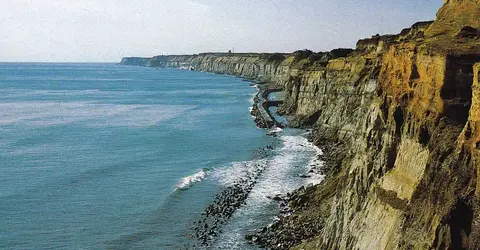
Byoubugaura Cliff, Choshi, Chiba Prefecture
@Japan Visitor
Tokawa Station
This is the terminus of the line. The historic streets of Tokawa, an old fishing village, are worth a stroll.
It's a longer walk to the Byoubugaura Cliff, a spectacular rock cliff stretching along the sea for several kilometers.
The Byoubugaura separates the Choshi Peninsula from the 60 km long, flat, sandy Kujukuri Beach to the south.
History
The line was first opened as Choshi Yuran Tetsudo (Choshi Sightseeing Railway) in 1913. It ran from Choshi Station to Inubo, with only four stops in between. Low passenger numbers led to the closing of the line in 1917, despite protests by local commuters.
The track bed was converted into a road traveled by buses while the stations remained intact.
In 1923, the line was once again opened as a rail line, named Choshi Railway. At that time, the line was extended to its current terminus, Tokawa Station. In 1925, the line was electrified.
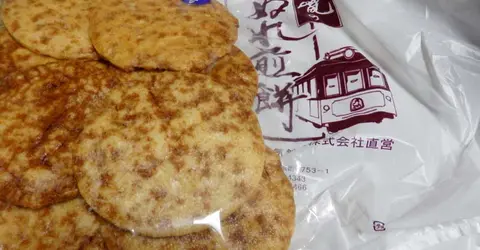
Nure-senbei sold by Choshi Dentetsu Railway
@Japan Visitor
Nure-senbei
Nure-senbei are moist rice crackers which are dipped in soy sauce while still hot from the baking. They were invented in about 1960 in Choshi, famous for its soy sauce production, and have been a local specialty ever since.
In the early 2000s, the Choshi Dentetsu Railway began selling their own brand of nure-senbei at all manned stations to create financial support for their train operations. By now, the profits generated with the rice crackers are much higher than the earnings achieved by passenger ticket sales.
Buy a pack. They are tasty, make good gifts and keep the wheels of the railway rolling.
Choshi Access
The fastest connection from Tokyo to Choshi offers the JR Sobu Main Line Limited Express Shiosai from Tokyo Station to Choshi Station (2 hours).
A slower but cheaper trip offers the option of traveling from Tokyo Station by a JR Sobu Main Line Rapid Train to Chiba Station and a change there to a JR Sobu Main Line Local Train to Choshi (2 and a half hours).
If starting from other Tokyo locations, the Sobu Line would be a good option. It runs all the way from Shinjuku Station through downtown Tokyo to Chiba Station, stopping at every major station in between. Change in Chiba to the Sobu Main Line Local Service to Choshi.








